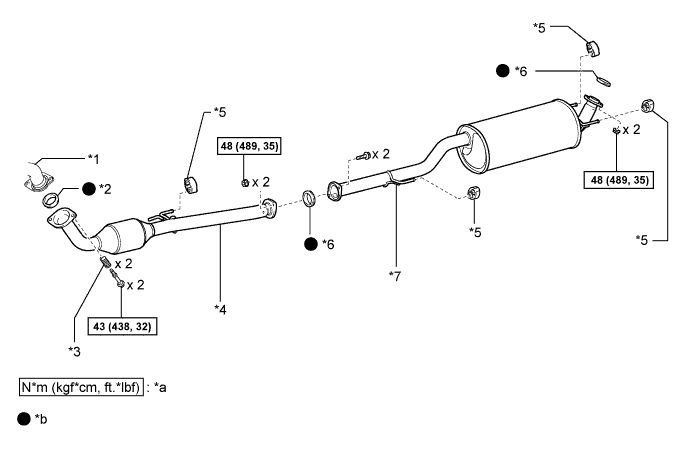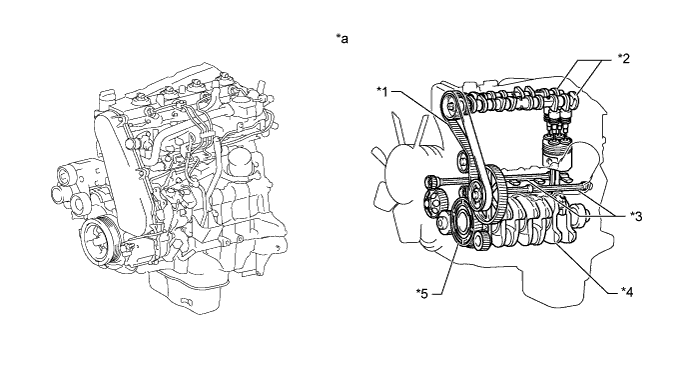DESCRIPTION
INSPECTION PROCEDURE
CONFIRM CONDITION IN WHICH NOISE OCCURRED
CONFIRM NOISE CUSTOMER MENTIONED (PROCEDURE 2)
CHECK INTAKE SYSTEM
CONFIRM NOISE SOURCE (FROM TURBOCHARGER OR NOT)
CONFIRM THE NOISE TYPE
PERFORM ALIGNMENT OF EXHAUST PIPE AND CONFIRM THE NOISE
CHECK FOR NOISE FROM SOURCE OTHER THAN TURBOCHARGER (PROCEDURE 7)
REPLACE THE PARTS DETECTED IN PROCEDURE 7
CONFIRM WHETHER MALFUNCTION HAS BEEN SUCCESSFULLY REPAIRED
EXPLAIN TO THE CUSTOMER THAT THE NOISE IS NORMAL
ECD SYSTEM (w/ EGR Cooler) - Turbocharger Noise |
DESCRIPTION
- HINT:
- Turbocharger noise is classified into 2 types. One is whistling noise, and the other is whining noise. When troubleshooting, the type of noise should be determined first.
DescriptionNoise Type
| Noise Description
| Main Trouble Area
|
Whistling noise
| The volume and pitch of this noise are proportional to turbocharger speed or engine speed. Therefore, the noise level will become more obvious when engine speed increases.
| - Turbocharger (e.g. shaft imbalance)
- Balance shafts
- Transmission gear
- Intake air system leakage
- Intake air system breakage
|
Whining noise
| This noise has a lower pitch than whistling noise. It generally occurs in the engine speed range of 1500 to 2500 rpm, and has a relatively constant pitch, independent of engine speed and vehicle speed.
| Turbocharger
- HINT:
- Example: Vibration of turbocharger is transferred to exhaust pipe which causes resonation and noise.
- Example: Vibration of turbocharger is transferred through exhaust pipe to vehicle body (floor) which then vibrates causing noise.
|
| Faults and Symptoms of Diesel Engine Components |
Turbocharger SystemMain fault
| Turbocharger turbine shaft imbalance
|
Symptoms
| High-pitched whistling noise
- HINT:
- The pitch and volume change in proportion to the turbocharger speed.
|
Intake SystemMain fault
| Leakage
|
Symptoms
| Leak flow noise
|
Balance Shaft GearSymptoms
| Gear noise
- HINT:
- The pitch and volume change in proportion to the engine speed.
|
Transmission GearSymptoms
| Gear noise
- HINT:
- The pitch and volume change in proportion to the transmission gear speed.
|
INSPECTION PROCEDURE
| 1.CONFIRM CONDITION IN WHICH NOISE OCCURRED |
Confirm with the customer the conditions in which the noise occurred.
- HINT:
- To clearly understand the conditions in which the noise occurred, the items in the table below are useful.
Item
| Note
|
Engine speed
| Engine speed range
|
Vehicle speed
| Vehicle speed range
|
Transmission gear
| Which gear?
|
Accelerator pedal position
| During acceleration or deceleration?
|
Temperature
| - Ambient temperature
- Engine temperature (cold, warmed up, etc.)
|
Road conditions
| - City or highway driving
- Uphill or downhill
|
Noise level
| - Did the noise occur suddenly, or build gradually?
- Has the noise gradually been getting louder?
|
Other symptoms
| - Lack of power
- High fuel consumption, etc.
|
Noise recognition
| What made the customer determine the noise to be abnormal?
|
| 2.CONFIRM NOISE CUSTOMER MENTIONED (PROCEDURE 2) |
Check for the noise described by the customer.
- HINT:
- If a noise is heard, make sure that the noise matches the noise described by the customer.
ResultResult
| Proceed to
|
Obvious abnormal noise matching noise described by customer is confirmed
| A
|
Obvious abnormal noise matching noise described by customer is not confirmed
| B
|
Check for air leakage between the air cleaner and turbocharger, and between the turbocharger and intake manifold.
- HINT:
- Check for disconnected or improperly connected hoses, and gaps between hoses and parts.
- Check for foreign matter between the air cleaner and turbocharger.
| | REPAIR OR REPLACE MALFUNCTIONING PARTS |
|
|
| 4.CONFIRM NOISE SOURCE (FROM TURBOCHARGER OR NOT) |
Connect the intelligent tester to the DLC3.
Start the engine and warm it up.
Turn the tester on.
Enter the following menus: Powertrain / Engine and ECT / Active Test / Activate the VN Turbo Open.
Perform the Active Test and rev the engine up several times.
Check whether the noise is reduced or not compared with the noise under the condition that the Active Test is not performed.
ResultResult
| Proceed to
|
The noise is reduced (or disappears)
| A
|
The noise is the same as in Procedure 2 (The noise does not change)
| B
|
- HINT:
- When the variable nozzle of the turbocharger opens fully regardless of the engine condition, the turbocharger speed slows down and the cause of noise can be confirmed that is from the turbocharger or not.
- If the turbocharger is the cause of the noise, the noise will be reduced when the variable nozzle opens because turbocharger speed does not increase.
Check whether the noise can be heard even when the engine speed is more than 3000 rpm, and whether the noise gradually gets louder as the engine speed increases.
- HINT:
- If so, the noise is likely to be whistling noise. If not, the noise is likely to be whining noise.
ResultResult
| Proceed to
|
Yes (The noise is likely to be whistling noise)
| A
|
No (The noise is likely to be whining noise)
| B
|
| 6.PERFORM ALIGNMENT OF EXHAUST PIPE AND CONFIRM THE NOISE |
Disconnect the exhaust pipe at the ball joint and from each exhaust pipe support, and then realign the exhaust pipe and reconnect it to each exhaust pipe support and at the ball joint (HILUX_TGN26 RM00000121E00SX.html).
Text in Illustration*1
| Outlet Pipe
| *2
| Gasket (Ball Joint)
|
*3
| Compression Spring
| *4
| Front Exhaust Pipe Assembly
|
*5
| Exhaust Pipe Support
| *6
| Gasket
|
*7
| Center Exhaust Pipe Assembly
| -
| -
|
*a
| Specified torque
| *b
| Non-reusable part
|
- HINT:
- Above illustration is an example.
Confirm whether the noise problem is solved or not.
- HINT:
- The alignment of the exhaust pipe affects whining noise.
ResultResult
| Proceed to
|
The noise problem is solved
| A
|
The noise problem remains
| B
|
| 7.CHECK FOR NOISE FROM SOURCE OTHER THAN TURBOCHARGER (PROCEDURE 7) |
Check for the noise source with a sound scope.
- NOTICE:
- When performing this check, make sure that the sound scope, your body, etc., do not get caught on the V-belt.
- HINT:
- The source of the noise is not the turbocharger, but a part other than the turbocharger (e.g. a part inside the engine, transmission, or vacuum pump).
- Sometimes gear noise may be mistaken for turbocharger noise. For gear noise, pay attention to the gear inside the engine and transmission gear.
- Rev the engine up and check if the noise reduces at the same time the engine speed decreases. If the noise reduces at the same time the engine speed decreases, it is gear noise. If the noise reduces a short time after the engine speed decreases, it is turbocharger noise.
- The following illustration is a reference for checking whether the noise source is from the engine.
Text in Illustration*1
| Timing Belt
| *2
| Camshafts
|
*3
| Balance Shafts
| *4
| Crankshaft
|
*5
| Timing Gear Train
| -
| -
|
*a
| Gear Location inside Engine
| -
| -
|
- HINT:
- Above illustration is an example.
- Gear noise can be confirmed with a sound scope. Put the sound scope on the cylinder block near the gear, and if the noise heard through the sound scope has the same timing as the noise heard without the sound scope, it is gear noise.
| 8.REPLACE THE PARTS DETECTED IN PROCEDURE 7 |
Replace the parts detected in Procedure 7 as the noise source.
| 9.CONFIRM WHETHER MALFUNCTION HAS BEEN SUCCESSFULLY REPAIRED |
Check whether the noise problem has been successfully solved.
| 10.EXPLAIN TO THE CUSTOMER THAT THE NOISE IS NORMAL |
Explain to the customer that the noise the customer mentioned is not abnormal.
- HINT:
- To help the customer understand, test driving another car with the customer may be helpful.

